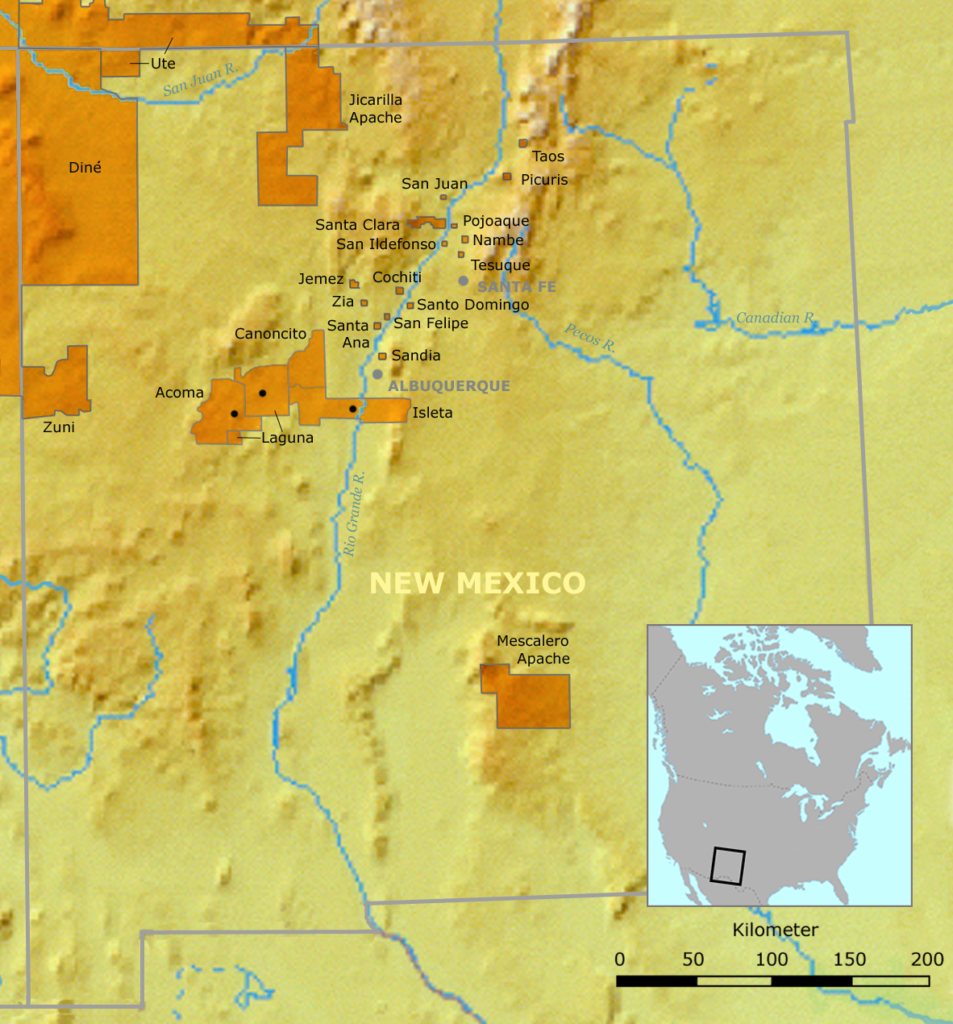August 10 marks the anniversary of the Pueblo Revolt against the Spaniards. This took place in 1680 and resulted in the expulsion of the Spanish presence for a period of twelve years. The consequences of this revolt continue to today.
New Mexico is home to nineteen Pueblos, all separate nations with their own government. They share elements of religion, although rituals and observances vary. The Pueblos have a similar lifestyle and philosophy, and have in common an economy that grew out of thousands of years of occupying the same geographical region. Languages vary greatly among the Pueblos. Although the Pueblo people have been present for a very long time, the term by which the outside world knows them best, Pueblos, originated with the Spaniards.

The seeds of the Revolt were planted in 1528, when Alvar Núñez Cabeza de Vaca and three other Spaniards survived a shipwreck off the coast of Galveston. They spent eight years wandering west. They were captured, escaped captivity and eventually reached Mexico City, where they related their experiences to the Spanish authorities, who had conquered the Aztecs sixteen years earlier.
Intrigued by Cabeza de Vaca’s reports, the Spaniards sent a small expedition north to explore the area. So it was that in 1539, the first contact occurred between a non-native person and inhabitants of the Zuni Pueblo. Almost sixty years later, in 1598, a major officially authorized colonizing expedition was launched by the Spanish authorities. The first Spanish settlement arose at Yunge Owingeh, across the Rio Grande Ohkay Owingeh Pueblo. These newcomers found the farming and community-dwelling people cooperative and peaceful. They referred to them as Indios de los Pueblos, in contrast to other groups to whom they referred as Indios Barbaros. (In return, the Pueblo people came up with descriptive monikers for the Spaniards: “Wearers of Metal,” “Metal People,” and “Wearers of Rock-Hard Metal.”)
In 1610, King Philip III agreed that the Spanish settlements in New Mexico should be maintained at royal expense. The function of the Spanish colonists, military and government would be to protect the missions and support them in the endeavors to convert people to Catholicism.
This colonization, with its introduction of animals never seen before, coupled with new agricultural techniques, resulted in serious consequences for the original inhabitants. Overgrazing by cattle brought erosion and the destruction of Pueblo farmlands. A drought in the early part of the 17th century added to the distress. Missionary efforts to find and destroy any material evidence of Pueblo religion, including kivas and katsinam was galling to the local population.
It was in this world that in 1630 Po’pay was born in Ohkay Owingeh. He became the leader of the Pueblo Revolt. We have very few sources, unflattering reports by the Spaniards and oral traditions within the Pueblo world. We do have a name: Po’pay. He was most likely a religious figure as well as a war captain. In 1675, Po’pay was among 47 men arrested by the Spaniards in an attempt to maintain control over the local population. Four men were sentenced to death, the others remained imprisoned for several years and were regularly subjected to public lashings. Among them was Po’pay.
Eventually, the governor released these prisoners on the condition that they “forsake their idolatry.” The year was 1677. The relations between the original inhabitants and the newcomers continued to grow worse. It became clear to the Pueblos that the Spaniards had to be driven out.
That rebellion, organized among the Pueblos, started on August 10, 1680. It ended on August 21, when the governor and surviving settlers, soldiers, friars and government officials left Santa Fe and headed south. It would take 12 years before the Spaniards managed to reassert control, and then on different terms with the Pueblos. The Pueblos were granted full citizenship and remained in the area where they have always lived. Although the Pueblos accepted Catholicism, they maintained their religion, which is still practiced today. The Pueblo Revolt prevented the cultural and racial genocide that occurred in the eastern United States. In 2005, the state of New Mexico unveiled a statue of Po’pay in the Rotunda of the US Capitol, one of two statues representing the state. It commemorates the role he played in maintaining and preserving Pueblo cultures.

Recommended reading:
Sando, Joe S., and Herman Agoyo, eds., 2005. Po’pay. Leader of the First American Revolution. Clear Light Publishing, Santa Fe, NM.

